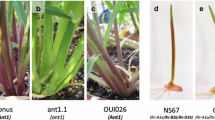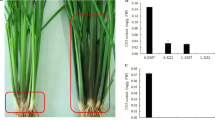Abstract
The erectoides-m anthocyanin-less 1 (ert-m ant1) double mutants are among the very few examples of induced double mutants in barley. From phenotypic observations of mutant plants it is known that the Ert-m gene product regulates plant architecture whereas the Ant1 gene product is involved in anthocyanin biosynthesis. We used a near-isogenic line of the cultivar Bowman, BW316 (ert-m.34), to create four F2-mapping populations by crosses to the barley cultivars Barke, Morex, Bowman and Quench. We phenotyped and genotyped 460 plants, allowing the ert-m mutation to be mapped to an interval of 4.7 cM on the short arm of barley chromosome 7H. Bioinformatic searches identified 21 candidate gene models in the mapped region. One gene was orthologous to a regulator of Arabidopsis thaliana plant architecture, ERECTA, encoding a leucine-rich repeat receptor-like kinase. Sequencing of HvERECTA in barley ert-m mutant accessions identified severe DNA changes in 15 mutants, including full gene deletions in ert-m.40 and ert-m.64. Both deletions, additionally causing anthocyanin deficiency, were found to stretch over a large region including two putative candidate genes for the anthocyanin biosynthesis locus Ant1. Analyses of ert-m and ant1 single- and double-deletion mutants suggest Ant1 as a closely linked gene encoding a R2R3 myeloblastosis transcription factor.











Similar content being viewed by others
References
Allen AC, Hellens RP, Laing WA (2008) MYB transcription factors that colour our fruit. Trends Plant Sci 13:99–102
Baker NR, Hardwick K (1973) Biochemical and physiological aspects of leaf development in cocoa (Theobroma cacao): i. Development of chlorophyll and photosynthetic activity. New Phytol 72:1315–1324
Bojar D, Martinez J, Santiago J, Rybin V, Bayliss R, Hothorn M (2014) Crystal structures of the phosphorylated BRI1 kinase domain and implications for brassinosteroid signal initiation. Plant J 78:31–43
Bothmer R, van Hintum T, Knüpffer H, Sato K (2003) Diversity in barley. Elsevier Science Publishers, Amsterdam
Cockram J, White J, Zuluaga DL, Smith D, Comadran J, Macaulay M, Luo Z, Kearsey MJ, Werner P, Harrap D, Tapsell C, Liu H, Hedley PE, Stein N, Schulte D, Steuernagel B, Marshall DF, Thomas WTB, Ramsay L, Mackay I, Balding DJ, Waugh R, O’Sullivan DM, AGOUEB Consortium (2010) Genome-wide association mapping to candidate polymorphism resolution in the unsequenced barley genome. Proc Natl Acad Sci USA 107(50):21611–21616
Delgado-Vargas F, Jiméne AR, Paredes-López O (2000) Natural pigments: carotenoids, anthocyanins, and betalains—characteristics, biosynthesis, processing and stability. Crit Rev Food Sci Nutr 40:173–289
Dockter C, Gruszka D, Braumann I, Druka A, Druka I, Franckowiak J, Gough SP, Janeczko A, Kurowska M, Lundqvist J, Lundqvist U, Marzec M, Matyszczak I, Müller AH, Oklestkova J, Schulz B, Zakhrabekova S, Hansson M (2014) Induced variations in brassinosteroid genes define barley height and sturdiness, and expand the “Green Revolution” genetic toolkit. Plant Physiol. doi:10.1104/pp.114.250738
Dörte K-H, Nurisso A, Pietraszewska-Bogiel A, Mbengue M, Camut S, Timmers T, Pichereaux C, Rossignol M, Gadelle TWJ, Imberty A, Lefebvre B, Cullimore JV (2011) Structure-function similarities between a plant receptor-like kinase and the human interleukin-1 receptor-associated kinase-4. J Biol Chem 286:11202–11210
Druka A, Kudrna D, Rostoks N, Brueggeman R, von Wettstein D, Kleinhofs A (2003) Chalcone isomerase gene from rice (Oryza sativa) and barley (Hordeum vulgare): physical, genetic and mutation mapping. Gene 302:171–178
Druka A, Franckowiak J, Lundqvist U, Bonar N, Alexander J, Houston K, Radovic S, Shahinnia F, Vendramin V, Morgante M, Stein N, Waugh R (2011) Genetic dissection of barley morphology and development. Plant Physiol 155:617–627
Du H, Zhang L, Liu L, Tang XF, Yang WJ, Wu YM, Huang YB, Tang YX (2009) Biochemical and molecular characterization of plant MYB transcription factor family. Biochemistry (Moscow) 74:1–11
Franckowiak JD, Lundqvist U (2012) Descriptions of barley genetic stocks for 2012. BGN 42:36–173
Gou X, He K, Yang H, Yuan T, Lin H, Clouse SD, Li J (2010) Genome-wide cloning and sequence analysis of leucine-rich repeat receptor-like protein kinase genes in Arabidopsis thaliana. BMC Genom 11:19
Hanks SK, Quinn AM (1991) Protein kinase catalytic domain sequence database: identification of conserved features of primary structure and classification of family members. Meth Enzymol 200:38–62
Himi E, Yamashita Y, Haruyama N, Yanagisawa T, Maekawa M, Taketa S (2012) Ant28 gene for proanthocyanidin synthesis encoding the R2R3 MYB domain protein (Hvmyb10) highly affects grain dormancy in barley. Euphytica 188:141–151
Hothorn M, Belkhadir Y, Dreux M, Dabi T, Noel J, Wilson IA, Chory J (2011) Structural basis of steroid hormone perception by the receptor kinase BRI1. Nature 474:467–471
IBSC (International Barley Sequencing Consortium) (2012) A physical, genetic and functional sequence assembly of the barley genome. Nature 491:711–716
Jende-Strid B (1984) Coordinator’s report: anthocyanin genes. Barley Genet Newsl 14:76–79
Jende-Strid B (1993) Genetic control of flavonoid biosynthesis in barley. Hereditas 119:187–204
Jones DT, Taylor WR, Thornton JM (1994) A model recognition approach to the prediction of all-helical membrane protein structure and topology. Biochemistry 33:3038–3049
Kristiansen KN, Rohde W (1991) Structure of the Hordeum vulgare gene encoding dihydroflavonol-4-reductase and molecular analysis of ant18 mutants blocked in flavonoid synthesis. Mol Gen Genet 230:49–59
Kyte J, Doolittle RF (1982) A simple method for displaying the hydropathic character of a protein. J Mol Biol 157:105–132
Lease KA, Lau NY, Schuster RA, Torii KU, Walker JC (2001) Receptor serine/threonine protein kinases in signaling: analysis of the erecta receptor-like kinase of Arabidopsis thaliana. New Phytol 151:133–143
Lee DW, Brammeier S, Smith AP (1987) The selective advantage of anthocyanins in developing leaves of mango and cacao. Biotropica 19:40–49
Lundqvist U (1992) Mutation research in barley. Dissertation, Swedish University of Agricultural Sciences
Lundqvist U (2009) Eighty years of Scandinavian barley mutation genetics and breeding. In: Shu QY (ed) Induced mutations in the genomics era. FAO, Rome, pp 39–43
Lundqvist U (2014) Scandinavian mutation research in barley—a historical review. Hereditas. doi:10.111/hrd2.2.00077
Mayer KFX, Martis M, Hedley PE, Simkova H, Liu H, Morris JA, Steuernagel B, Taudien S, Roessner S, Gundlach H, Kubalakova M, Suchankova P, Murat F, Felder M, Nussbaumer T, Graner A, Salse J, Endo T, Sakai H, Tanaka T, Itoh T, Sato K, Platzer M, Matsumoto T, Scholz U, Dolezel J, Waugh R, Stein N (2011) Unlocking the barley genome by chromosomal and comparative genomics. Plant Cell 23:1249–1263
Michalek W, Künzel G, Graner A (1999) Sequence analysis and gene identification in a set of mapped RFLP markers in barley (Hordeum vulgare). Genome 42:849–853
Nakamura A, Fujioka S, Sunohara H, Kamiya N, Hong Z, Inukai Y, Miura K, Takatsuto S, Yoshida S, Ueguchi-Tanaka M, Hasegawa Y, Kitano Matsuoka M (2006) The role of OsBRI1 and its homologous genes, OsBRL1 and OsBRL3, in rice. Plant Physiol 140:580–590
Ngaki MN, Louie GV, Philippe RN, Manning G, Pojer F, Bowman ME, Li L, Larsen E, Wurtele ES, Noel JP (2012) Evolution of the chalcone-isomerase fold from fatty-acid binding to stereospecific catalysis. Nature 485:530–533
Noodén LD, Hillsberg JW, Schneider MJ (1996) Induction of leaf senescence in Arabidopsis thaliana by long days through a light-dosage effect. Physiol Plant 96:491–495
Oh M-H, Wanng X, Kim SY, Wu X, Clouse SD, Huber SC (2014) The carboxy-terminus of BAK1 regulates kinase activity and is required for normal growth of Arabidopsis. Front Plant Sci. 5:16
Paterson AH, Bowers JE, Bruggmann R, Dubchak I, Grimwood J, Gundlach H, Haberer G, Hellsten U, Mitros T, Poliakov A, Schmutz J, Spannagl M, Tang H, Wang X, Wicker T, Bharti AK, Chapman J, Feltus FA, Gowik U, Grigoriev IV, Lyons E, Maher CA, Martis M, Narechania A, Otillar RP, Penning BW, Salamov AA, Wang Y, Zhang L, Carpita NC, Freeling M, Gingle AR, Hash CT, Keller B, Klein P, Kresovich S, McCann MC, Ming R, Peterson DG, Mehboob-ur-Rahman, Ware D, Westhoff P, Mayer KFX, Messing J, Rokhsar DS (2009) The Sorghum bicolor genome and the diversification of grasses. Nature 457:551–556
Persson G, Hagberg A (1969) Induced variation in a quantitative character in barley. Morphology and cytogenetics of erectoides mutants. Hereditas 61:115–178
Pilu R, Piazza P, Petroni K, Ronchi A, Martin C, Tonelli C (2003) pl-bol3, a complex allele of the anthocyanin regulatory pl1 locus that arose in a naturally occurring maize population. Plant J 36:510–516
She J, Han Z, Kim T-W, Wang J, Cheng W, Chang J, Shi S, Wang J, Yang M, Wang Z-Y, Chai J (2011) Structural insight into brassinosteroid perception by BRI1. Nature 474:472–476
Shih CH, Chu H, Tang LK, Sakamoto W, Maekawa M, Chu IK, Wang M, Lo C (2014) Functional characterization of key structural genes in rice flavonoid biosynthesis. Plant Cell Environ 37:1716–1721
Shiu SH, Bleecker AB (2001) Receptor-like kinases from Arabidopsis form a monophyletic gene family related to animal receptor kinases. Proc Natl Acad Sci USA 98:10763–10768
Singh R, Low E-TL, Ooi LC-L, Ong-Abdullah M, Nookiah R, Ting N-C, Marjuni M, Chan P-L, Ithnin M, Manaf MAA, Nagappan J, Chan K-L, Rosli R, Halim MA, Azizi N, Budiman MA, Lakey N, Bacher B, van Brunt A, Wang C (2014) The oil palm VIRESCENS gene controls fruit colour and encodes a R2R3-MYB. Nat Commun 5:4106
Stracke R, Werber M, Weisshaar B (2001) The R2R3-MYB gene family in Arabidopsis thaliana. Curr Opinion Plant Biol 4:447–456
Torii KU (2013) Mix-and-match: ligand-receptor pairs in stomatal development and beyond. Trends Plant Sci 17:711–719
Torii K, Mitsukawa N, Oosumi T, Matsuura Y, Yokoyama R, Whittier R, Komeda Y (1996) The Arabidopsis ERECTA gene encodes a putative receptor protein kinase with extracellular leucine-rich repeats. Plant Cell 8:735–746
van Zanten M, Snoek LB, Proveniers MCG, Peeters AJM (2009) The many functions of ERECTA. Trends Plant Sci 14:214–218
von Wettstein D, Jende-Strid B, Ahrenst-Larsen B, Erdal K (1977) Biochemical mutant in barley renders chemical stabilization of beer superfluous. Carlsberg Res Commun 42:341–351
Wang X, Olsen O, Knudsen S (1993) Expression of the dihydroflavonol reductase gene in an anthocyanin-free barley mutant. Hereditas 119:67–75
Wang Z, Liu J, Sudom A, Ayres M, Li S, Wesche H, Powers JP, Walker NP (2006) Crystal structures of IRAK-4 kinase in complex with inhibitors: a serine/threonine kinase with tyrosine as a gatekeeper. Structure 14:1835–1844
Xu W, Huang J, Li B, Wang Y (2008) Is kinase activity essential for biological functions of BRI1? Cell Res 18:472–478
Yamagishi M, Toda S, Tasaki K (2014) The novel allele of the LhMYB12 gene is involved in splatter-type spot formation on the flower tepals of Asiatic hybrid lilies (Lilium spp.). New Phytologist 201:1009–1020
Acknowledgments
We thank Mateusz Kania for excellent technical assistance. This work was supported by the Carlsberg Foundation, GUDP (Denmark, 34009-12-0522), Deutsche Forschungsgemeinschaft (Germany, DO1482/1-1), the Nilsson-Ehle Foundation at the Royal Physiographic Society in Lund, and the Erik Philip-Sörensen Foundation.
Author information
Authors and Affiliations
Corresponding author
Ethics declarations
Conflict of interest
Carlsberg has supported and financed a major part of this work and the right to publish is granted under the provision that Carlsberg maintains all rights (incl. future intellectual property rights granted to new industrial collaborators) to use the genes, traits and phenotypes described in the publication to advance current and future commercial interests of the Carlsberg Group.
Additional information
Shakhira Zakhrabekova and Christoph Dockter have contributed equally to this work.
Rights and permissions
About this article
Cite this article
Zakhrabekova, S., Dockter, C., Ahmann, K. et al. Genetic linkage facilitates cloning of Ert-m regulating plant architecture in barley and identified a strong candidate of Ant1 involved in anthocyanin biosynthesis. Plant Mol Biol 88, 609–626 (2015). https://doi.org/10.1007/s11103-015-0350-x
Received:
Accepted:
Published:
Issue Date:
DOI: https://doi.org/10.1007/s11103-015-0350-x




